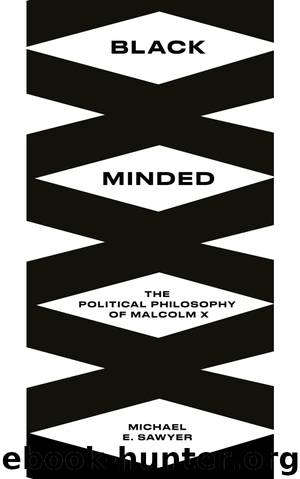Black Minded by Michael E. Sawyer;

Author:Michael E. Sawyer;
Language: eng
Format: epub
Publisher: Book Network Int'l Limited trading as NBN International (NBNi)
Figure 6 Muhammad Ali and Malcolm X (Bob Gomel/Sygma, via Getty Images)
There are the obvious elements of time and space that must be accounted for here. Figure 6 is one of a series of photographs taken of the celebration at the diner in the Hampton House Hotel in Miami, hours after Cassius Clay’s unexpected defeat of Sonny Liston on February 24, 1964. Before addressing the central figures in this image – teacher and pupil, watcher and watched, photographer and photographed – the room must be examined from the periphery inward, to witness the performance of radical political subjectivity expressed here.
There appear to be three white men in the scene, one in a suit and horn-rimmed glasses, his eyes focused away from the subjects of the photograph and his comportment disorientated. In the world assembled here and memorialized in the photograph, the white man has been pushed to the periphery, even here at this lunch counter, which has been altered from its employment as the locus of dehumanizing coercive threat to the Black body. The notion that Black people could occupy the lunch counter in this fashion, while pushing white men to the periphery, is emblematic of the performance of the philosophical system in this space. Additionally, the center of gravity of the scene is Cassius Clay and Malcolm X – not a white man.
To the right of this first white man, and against the wall, is another white man who appears to be an employee of the diner. The logic of this inversion of the racial hierarchy continues here in that, in contradistinction to the images of diner employees expelling Black bodies from lunch counters or denying them service, this individual is pushed as far from the counter as possible and seems to be engaged in serving a room full of African–Americans who have “Blackened” the space. The third white man is in uniform. A police officer is here and his kinetic coercive threat has been overwhelmed and decentered.
The next figure that attracts my attention in the same photograph is the Black woman, here in this profoundly gendered space. It is not news that the Nation of Islam operates under the debilitating regime of patriarchy. This woman is one who has resisted exclusion from this space and this embodied presence must be marked for its importance in its singularity. She appears determined to move to the center of the action. This situation of being present yet decentered, as captured in the photograph, exemplifies the troubling legacy of misogyny that must be interrogated in this system of thought. This gendered body finds itself singular and decentered in the dominant, Black, male phantasm that characterizes much of the thinking of Malcolm X.
bell hooks, in the essay, “Malcolm X: The Longed-for Feminist Manhood,” asserts that, at least when Outlaw Culture: Resisting Representation was first published, in 1994, “[c]ritical scholarship on Malcolm X contains no substantial work from a feminist standpoint.”16 Both hooks, in the essay referred to, and Clenora Hudson-Weems, in a 1993
Download
This site does not store any files on its server. We only index and link to content provided by other sites. Please contact the content providers to delete copyright contents if any and email us, we'll remove relevant links or contents immediately.
| African-American Studies | Asian American Studies |
| Disabled | Ethnic Studies |
| Hispanic American Studies | LGBT |
| Minority Studies | Native American Studies |
Cecilia; Or, Memoirs of an Heiress — Volume 1 by Fanny Burney(32061)
Cecilia; Or, Memoirs of an Heiress — Volume 3 by Fanny Burney(31456)
Cecilia; Or, Memoirs of an Heiress — Volume 2 by Fanny Burney(31408)
The Great Music City by Andrea Baker(30780)
We're Going to Need More Wine by Gabrielle Union(18631)
All the Missing Girls by Megan Miranda(14726)
Pimp by Iceberg Slim(13777)
Bombshells: Glamour Girls of a Lifetime by Sullivan Steve(13683)
Fifty Shades Freed by E L James(12910)
Talking to Strangers by Malcolm Gladwell(12869)
Norse Mythology by Gaiman Neil(12825)
For the Love of Europe by Rick Steves(11456)
Crazy Rich Asians by Kevin Kwan(8886)
Mindhunter: Inside the FBI's Elite Serial Crime Unit by John E. Douglas & Mark Olshaker(8699)
The Lost Art of Listening by Michael P. Nichols(7159)
Enlightenment Now: The Case for Reason, Science, Humanism, and Progress by Steven Pinker(6871)
The Four Agreements by Don Miguel Ruiz(6316)
Bad Blood by John Carreyrou(6275)
Weapons of Math Destruction by Cathy O'Neil(5829)
